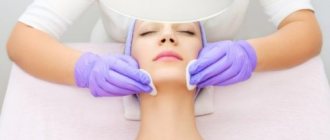Lip augmentation is a cosmetic procedure that can create fuller, plumper lips.
These days, injectable dermal filler is the most commonly used method of lip augmentation.
There are many types of dermal fillers that can be injected into the lips and around the mouth. But the most common fillers today are products containing substances similar to hyaluronic acid. Hyaluronic acid is a natural substance found in the body. Helps increase lip volume.
These types of dermal fillers are sometimes called "hyaluronic acid fillers."
- Collagen, once the most common dermal filler, is used less and less today. The new options are safer and the effects last longer.
- Fat injections and implants are another way to plump your lips. But they are not used as often today because results vary and there is a greater risk of side effects.
Using fillers with hyaluronic acid
Hyaluronic acid fillers can improve the appearance of your lips by adding:
- form
- compound
- volume
The effect usually lasts about six months. After this, you need to give more injections so that your lips do not change.
There are several hyaluronic acid fillers on the market. Among them are the following products:
- Restylane, Restylane-L, Restylane Silk
- Juvederm Ultra, Juvederm Ultra Plus, Juvederm Volbella XC
- Belotero Balance
- HylaForm
- Elevess
- Prevelle Silk
All of these products are administered the same way and produce the same results. And some contain lidocaine, a local anesthetic.
Baby
The 19th week is characterized for the fetus by intensive growth of the limbs in length, an increase in size, and a slowdown in head growth. Its length is already 25 cm, and its weight is approximately 250-300 g. The child changes greatly in appearance, his body no longer looks disproportionate.
The fat under the skin allows the relief of the body to change slightly and become rounded. This brown fat is formed at 19-20 weeks. After birth, it is he who will perform the function of thermoregulation and protect the child from hypothermia or overheating. With age, this fat disappears and remains only in certain places: in the thickness of a person’s cheeks, kidney area, under the armpits, and shoulder blades.
At this stage, the formation of permanent teeth, which are located in the dental plate under the rudiments of milk teeth, and the maturation of the brain also occur. Special processes allow connections between neurons to be established. Cells intertwine with each other and create a whole system for transmitting impulses, ensuring the synchrony of the brain. The structures responsible for touch, taste, vision, hearing, and smell are actively developing.
Changes also occur in the hematopoietic system. The spleen is connected to the process of formation of blood cells, produces leukocytes, the task of which is to protect the child’s body from external and internal factors. Until 19-20 weeks, the fetal blood consisted only of red blood cells, and at this stage its composition changes sharply and approaches the composition of the blood of a newborn.
Benefits of Hyaluronic Acid Fillers
Once injected, the gel in the filler supports and shapes the lip tissue.
The benefits of using hyaluronic acid fillers include:
- Control of lip volume. The amount of substance injected can be controlled so that the doctor can better control the volume of the lips.
- Gradual pace of treatment. The injections can be given gradually over different appointments until the desired results are achieved.
- Irregularities are easily dissolved. Any lumps or lumps created by moving your lips will easily dissolve.
- Less bruising. There may be less bruising and swelling compared to other dermal fillers.
- Quite stable results. The results are quite long lasting, but not permanent.
- An allergic reaction is unlikely. Because hyaluronic acid fillers are made from substances similar to those found in the body, they are unlikely to cause an allergic reaction. But if you are allergic to lidocaine, tell your doctor before treatment.
Why is it not advisable to get Botox injections during pregnancy and breastfeeding?
As Dr. Naidu explained, there have been no clinical trials examining the effects of the botulinum toxin found in Botox, Dysport, Juvo and Xeomin on pregnant women. Despite this, anecdotal evidence and clinical practice have led many experts to conclude that Botox and similar drugs administered during pregnancy will not cause harm.
Botox injections
One study showed that the botulinum toxin molecule is so heavy that it is extremely difficult for it to penetrate the placenta. In theory, it should be safe to use during pregnancy. But due to the lack of confirmed data on the absence of complications, it is better not to take risks.
Another New York-based scientist, Dr. Morgan Rabach, said he would never administer drugs like Botox to breastfeeding mothers because it is unknown whether they pass into milk. This is why such beauty injections are not given during lactation.
Side effects and risks
The side effects of hyaluronic acid fillers are temporary and should only last a few days. These may include:
- bleeding from injection sites;
- swelling and bruising;
- redness and soreness at the injection site;
- reactivation of cold sores or blisters (herpes simplex) on or around the lips.
More serious side effects or risks may include:
- severe and prolonged swelling or bruising lasting one week to 10 days;
- lip asymmetry (parts of the lips of different sizes);
- lumps and unevenness on the lips;
- infection;
- injection into a blood vessel causing tissue loss
- ulceration, scarring, or hardening of the lip;
- an allergic reaction that causes redness, swelling, or itching around the lips.
If you develop a fever or severe swelling, you should call your doctor immediately.
Third trimester - diet correction
From the 27th week of pregnancy, the female body begins to prepare for childbirth, and the baby begins to be born. At this time, gastronomic fads give way to heartburn, constipation, shortness of breath, swelling, and rapid weight gain.
A properly composed menu will help you adjust your well-being in the 3rd trimester. What should be done:
• Reduce the amount of protein foods. A protein surplus leads to kidney dysfunction and the accumulation of uric acid. • Avoid heartburn triggers - sour foods, black coffee, fried foods. • Replace 50% of animal fats with vegetable oils. They contain essential polyunsaturated acids Omega-3 and Omega-6, which are not synthesized by the body, but are needed for the absorption of minerals and vitamins. • Limit salty foods. Salt is the cause of edema, unstable functioning of the kidneys, heart, and blood vessels. • Set a limit on sweets. Simple carbohydrates quickly turn into extra pounds, causing flatulence, dyspepsia, and skin problems. • Eat more vegetables, fruits, berries, greens. Natural sources of vitamins provide energy and strengthen the immune system - this will come in handy during childbirth. Standards for KBJU: calories - 2900-3100, proteins - 100 g, fats - 75 g, carbohydrates - 400 g.
Is lip augmentation right for you?
To answer this question, you must first ask yourself why you want to change your lips. You should not undergo this procedure unless you really want to change your appearance.
If you're considering lip augmentation to make someone happy or to try to create the perfect look, think twice.
It is also important to have realistic expectations about the outcome. Extended lips can make your lips look plump and full, but you'll still be yourself when you step out of the doctor's office.
Before undergoing lip augmentation surgery, you must be healthy and not smoke. You may not be a candidate for lip augmentation if you have:
- active infection, such as oral herpes;
- diabetes;
- lupus;
- problems with blood clotting.
Second trimester - needs increase
By about 14-15 weeks, the woman’s well-being returns to normal - toxicosis goes away, physical and emotional activity increases. The baby begins to produce blood cells, strengthens bone tissue, the pituitary gland begins to work, the first hair and nails appear, bone mineralization progresses, and muscles begin to contract. To meet the increased needs of the child, the mother needs to eat more. At the same time, it is not the caloric intake that needs to be increased, but the amount of nutrients. At this time, both organisms need vitamin D, calcium, and iron.
Mandatory foods in the diet:
• to provide calcium - cheese, cottage cheese, milk, almonds, sesame seeds; • sources of vitamin D - fatty fish, cod liver, eggs, butter, flaxseed, olive oil; • for the prevention of iron deficiency - beef and pork liver, cocoa, beans, cabbage, apples, blueberries, greens (spinach, parsley, mint). In the second trimester, it is important to control the amount of table salt and fluid you drink. This will help avoid surges in blood pressure and cardiac overload. Recommended values: calories - 2800-3000, proteins - 120 g, fats - 85 g, carbohydrates - 400 g.
What you should tell your doctor before lip augmentation
Your doctor can discuss the pros and cons of your lip augmentation options with you and help you decide which method or product is best for you. But you should also tell him all the information about yourself:
- if you have ever had herpes in the past;
- known allergies or allergies to lidocaine;
- about any medications you take, including prescription and over-the-counter medications;
- as well as herbal supplements.
The most important thing is to find a doctor who is qualified and experienced in administering injections and who you trust.
Don't go to just anyone. Lip augmentation poses a real risk, especially if the person doing the injection is inexperienced. When deciding which doctor to see, ask about his or her training and education. How many injections did he have? Are they a board-certified physician or member of a medical association in their specialty? Also ask to see before and after photos of patients the doctor has treated.
Fetal development in the 1st trimester of pregnancy (1-12 weeks)
10-14 day
delay in menstruation is a reason to consult a gynecologist.
The 1st trimester of pregnancy is considered to be the period of development of the embryo (fetus) from the moment of fertilization of the egg and attachment of the zygote (fertilized egg) to the wall of the uterus until the 12th week.
This stage is characterized by a sequential change
of blastogenesis, organogenesis, placentary
, and also includes
the beginning of the fetal period
, when the fetus has already formed all organ systems, limbs and even the visual appearance of the baby.
It is the 1st trimester of pregnancy that obstetricians and gynecologists call “critical,” because, on the one hand, during this period, the most complex dynamic processes occur in a woman’s body: fertilization, the attachment of the zygote, the formation of all systems of the baby’s body. On the other hand, it is during this period that the fetus is most sensitive to damaging factors, so there is a possibility of pregnancy complications and abnormalities in the development of the fetus, if there are prerequisites for this. Moreover, this risk is even higher than in the 2nd or 3rd trimesters of pregnancy. Non-developing pregnancy
- one of the most significant and common risks that can appear already in early pregnancy.
Mothers who have previously faced the problem of infertility, miscarriage, or ectopic pregnancy
.
The obstetrician-gynecologists of our clinic
will not only conduct prenatal diagnostics themselves as part of a program for monitoring the baby’s development, but will also help correct pathologies in the development of the fetus in a hospital setting.
We manage pregnancies after IVF and have been helping women experience the joy of motherhood for over 20 years.
How is 1-2 weeks of pregnancy going?
Pregnancy period is calculated from the 1st day of the last menstruation
. Pregnancy begins with ovulation and fertilization. At this stage, the zygote attaches to the uterine cavity. It is extremely important that the anatomy (patency) of a woman’s fallopian tubes is not disturbed. The endometrium must be ready to receive a zygote, and there should be no inflammatory processes in the uterine cavity (its mucous membrane) - this increases the likelihood of low placentation. The movement of the zygote through the fallopian tube takes, on average, 2-3 days. Violation of the patency of the fallopian tubes and, in connection with this, the retention of a fertilized egg can cause an ectopic pregnancy.
As part of the planning and management of pregnancy (in the 1st trimester), a woman undergoes ultrasound diagnostics
, and also takes
tests
aimed at identifying such deviations. It is at this stage of pregnancy that it is already possible to determine the fertilized egg in the uterus and, for example, to exclude an ectopic pregnancy.
The main indicator by which pregnancy is diagnosed and its development is further monitored is the hCG level
(human chorionic gonadotropin) in the blood. If the pregnancy test result is positive, the hCG level exceeds 30. Pregnancy can be diagnosed using hCG within 2-4 days after a missed period.
At the initial stage of pregnancy in the 1st trimester, it is extremely important to compensate for the deficiency of nutrients (iron, magnesium, folic acid), which provide the necessary components for fetal growth, and restore hormonal balance. This must be done strictly under the supervision of a doctor and after undergoing tests - spontaneous use of medications, even herbal ones, can cause irreparable damage to the health of the mother and child.*
*
A notorious historical example is the thalidamide disaster of 1961.
How is 3-8 weeks of pregnancy going?
The embryo develops organs: heart, neural tube, intestines, etc. The placenta performs a number of vital functions: nutrition, respiration, excretion, synthesis of hormones and nutrients, blood circulation. The processes of active protein synthesis and embryonic growth factors require a good blood supply from the mother.
Organogenesis from the 3rd week of pregnancy is considered the most important and risky period of development. Any internal failure in the ligament: “mother - placenta - developing organs of the embryo”
can lead to fatal developmental defects.
At 6-7 weeks
During pregnancy, ultrasound diagnostics can already record the baby’s heartbeat.
At 7-8 weeks
During the 1st trimester of pregnancy, the fetus's limbs are formed, the process of embryogenesis is completed - this means that the embryo has all its organs and tissues formed in its infancy.
The period of 7-8 weeks is optimal in order to undergo the first large-scale clinical and laboratory examination and register.
You can contact our clinic regarding pregnancy management in the 1st trimester - we will issue an exchange card for the expectant mother and help her undergo modern diagnostics in a comfortable environment.
How is the 9th - 12th week of pregnancy?
The stage of active growth and complexity of the baby’s body. The fetus develops a lymphatic system and complex reflexes appear - the child can cover his face with his palms, or bring his thumb to his mouth.
Thus, in the 1st trimester of pregnancy, the most important and significant changes occur in a woman’s body - it begins to work literally for two, directing resources to the active growth and development of the fetus. To ensure good blood circulation, the work of the heart increases. To ensure that the baby receives the necessary amount of oxygen, pulmonary ventilation becomes more intense. The kidneys are now responsible for removing waste products from the mother and fetus. The uterus increases in size, which often leads to stagnant movements in the intestines - constipation. Taste sensations change; a woman may experience nausea and toxicosis
in the 1st trimester of pregnancy. Mild toxicosis in early pregnancy is treated with medication. Moderate and severe toxicosis in the 1st trimester of pregnancy is treated in a day hospital (for example, using hormonal infusion therapy).
It is important that the expectant mother not only undergoes examinations according to the program, but also receives support. When contacting our clinic regarding pregnancy management in the 1st trimester, you can count on the help of highly professional obstetricians and gynecologists, constant feedback from the doctor, and the European level of medical service.











